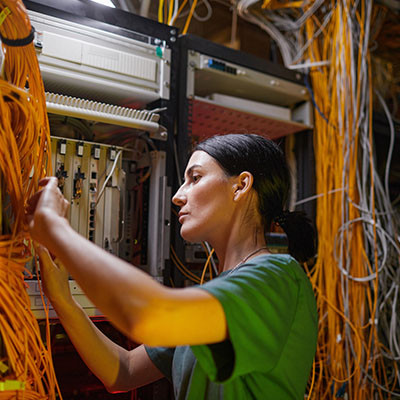BNMC Blog
Running Cables for IT Needs Structure
A lot of businesses are choosing to embrace some semblance of remote work. This has made networking your business simpler. If your staff is coming and going from your office, you can, by all practical means, avoid using cabled hardware in the front of your business. Unfortunately, most businesses do need to have some workstations and other IT connected and it can get messy quickly.
Why Does Cable Installation Matter?
Cable installation might not be the most glamorous aspect of business technology, but it's quite obviously one of the most critical. The fact is that if you run cables and wires in your business, and you don’t have a plan in which to effectively do so, you will be left with an impossible mess that not only is an eyesore, it can cause support costs to soar.
Having a cabling plan when setting up a new server, rearranging the office to support employee productivity, or setting up a new office, supports various crucial functions of your business. These include:
- Data Transfer - In an era of big data, businesses need a network infrastructure that can handle large volumes of data quickly and efficiently. High-quality cables are essential for data transfer, ensuring that information flows smoothly between devices and systems.
- Network Reliability - Network downtime can be costly and frustrating. Quality cable installation minimizes the risk of network interruptions, providing everyone on site a reliable Internet or Intranet connection.
- Future-Proofing - Technology is constantly evolving, laying the right cables today can help future-proof your business. Installing high-quality, high-capacity cables can ensure that your network infrastructure can accommodate new technologies and higher data demands as they emerge.
Tools of the Trade
There are more than just power and “Ethernet” cables involved with business computing, but even if that’s all there were, you can’t just have them lying around and individually running across the hallway wall, impeding doorway crossings, and just being unsightly.
There are several types of cables commonly used in business technology. It's good to know what they are and how you can use them for your specific needs. Here are some of the most common types:
- Ethernet Cables - Ethernet cables, such as Cat 5e, Cat 6, and Cat 6a, are the most commonly used for local area networks (LANs). They come in various speeds and are ideal for connecting computers, printers, and other devices within your office.
- Fiber Optic Cables - Fiber optic cables offer high-speed, long-distance data transmission. They are perfect for connecting different parts of your business over extended distances or for businesses with high data transfer needs.
- Coaxial Cables - Coaxial cables are commonly used for cable television and internet connections. They can also be used for security systems and CCTV.
- USB Cables - USB cables are used for connecting various devices to computers and servers. They are especially important for peripheral devices like printers, scanners, and external hard drives.
- Power Cables - Typically power cables are short and need to be addressed near the machine. Either way they have to be accounted for and managed properly.
The Importance of Professional Installation
While some businesses may attempt to handle cable installation in-house, it's often wise to enlist a professional perspective. Our consultants are always available to build a strategy to help you accomplish your technology goals. Give us a call today at (978) 482-2020 to learn more about how we can help your business sort out your technology goals.




Comments